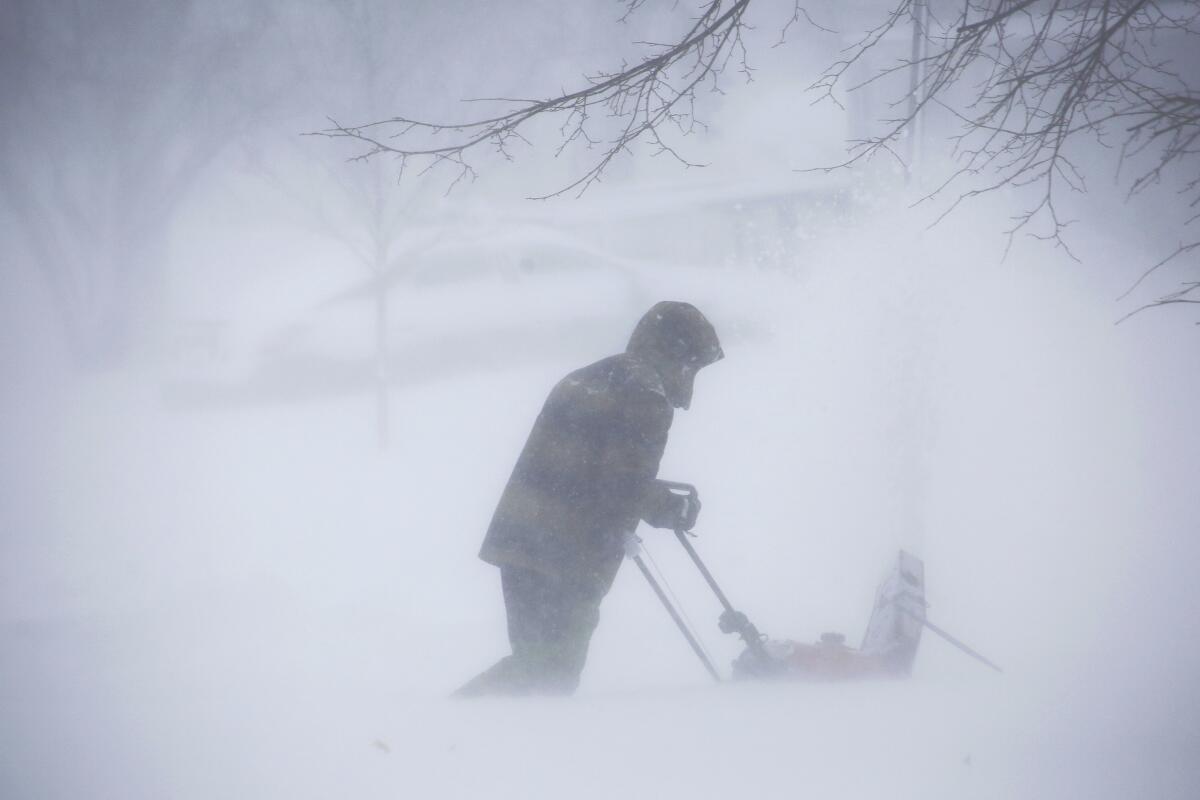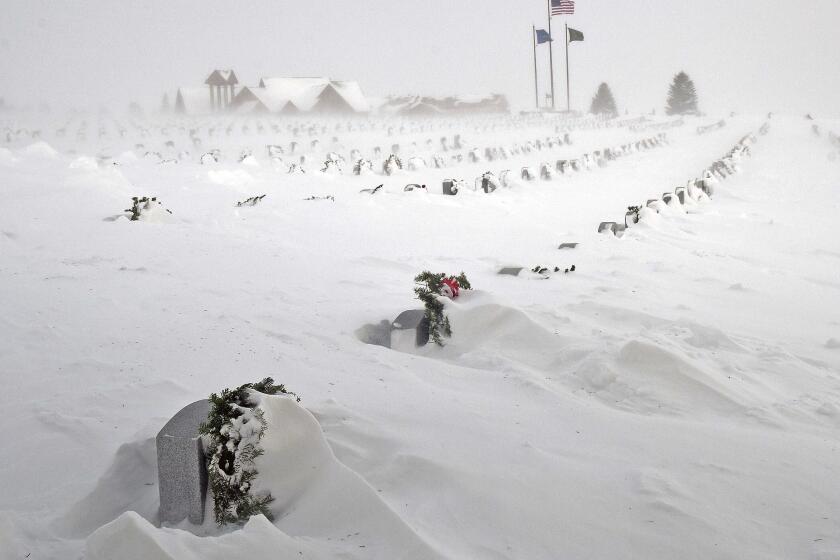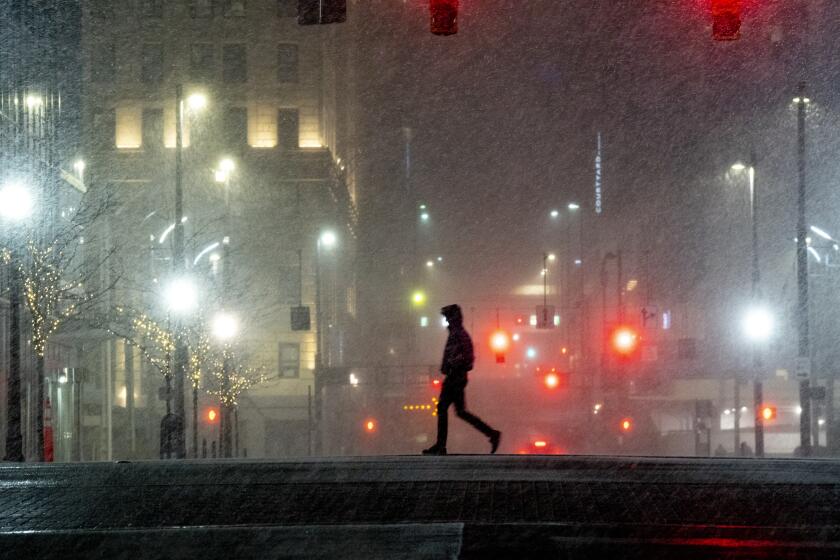Wild winter storm grips U.S., snarling holiday travel and leaving at least 18 dead

- Share via
BUFFALO, N.Y. — A frigid winter storm killed at least 18 people as it swept across the country, knocking out power to hundreds of thousands of homes and businesses and leaving millions of people on edge about the possibility of Christmas Eve blackouts.
The storm unleashed its full fury on Buffalo, N.Y., with hurricane-force winds causing whiteout conditions. Emergency response efforts were paralyzed, and the city’s international airport was shut down.
Officials across the U.S. have attributed deaths to exposure, car crashes, a falling tree limb and other effects of the storm. At least three people died in the Buffalo area, including two who suffered medical emergencies in their homes and couldn’t be saved because emergency crews were unable to reach them amid historic blizzard conditions.
Single-digit temperatures and daylong power outages sent Buffalo residents scrambling Saturday to get out of their houses to anywhere that had heat. New York Gov. Kathy Hochul said the Buffalo Niagara International Airport would be closed through Monday morning, and almost every fire truck in the city was stranded in the deep snow.
“No matter how many emergency vehicles we have, they cannot get through the conditions as we speak,” Hochul said.
Blinding blizzards, freezing rain and frigid cold also knocked out power from Maine to Seattle, while a major electricity grid operator warned the 65 million people it serves in the Eastern U.S. that rolling blackouts might be required.
Pennsylvania-based PJM Interconnection said power plants were having difficulty operating in the frigid weather and asked residents in 13 states to refrain from unnecessary use of electricity, warning that rolling blackouts might be required.
The Tennessee Valley Authority, which provides electricity to 10 million people in Tennessee and parts of six surrounding states, had directed local power companies to implement planned interruptions, but ended the measure by Saturday afternoon.
Across the six New England states, over 273,000 customers remained without power on Saturday, with Maine hit the hardest. Some utilities said it might be days before electricity could be restored.
A massive storm that forecasters say is nearly unprecedented in scope sends temperatures crashing, creates whiteout conditions and causes outages in much of the country.
In North Carolina, 11,000 customers were without power Saturday evening, down from 169,000 earlier in the day, according to PowerOutage.us. James Reynolds of Greensboro said his housemate, a 70-year-old with diabetes and severe arthritis, spent the morning bundled beside a kerosene heater with indoor temperatures “hovering in the 50s.”
In the Buffalo suburb of Cheektowaga, two people died in their homes Friday when emergency crews could not reach them in time to treat their medical conditions, according to Erie County Executive Mark Poloncarz, who said the storm may be “the worst ... in our community’s history.”
Forecasters said 28 inches of snow had accumulated in Buffalo — part of an area that saw 6 feet fall just over a month ago, resulting in three deaths. More was expected overnight.
Brian LaPrade woke up Saturday morning to find temperatures in his Buffalo house dipping below 50 degrees Fahrenheit after the snowfall blocked his furnace.
“I had to go out and dig out the vents,” LaPrade told the Associated Press. “As it was, the snow was taller than my snow blower.”
In areas of Erie County where ambulances could get through the snow, they were taking over three hours for one trip to a hospital, Poloncarz said. Plows were on the roads, but large snow drifts, abandoned cars and downed power lines were slowing their progress.
High-pressure ridges and continental mountain ranges are helping protect the Golden State from the dangerous deep freeze.
In Ohio, a utility worker was killed Friday while trying to restore power, according to the Buckeye Rural Electric Cooperative. The utility said the 22-year-old died in “an electrical contact incident” near Pedro in Lawrence County.
A woman in Vermont died in a hospital Friday after a tree broke in the high winds and fell on her. Police in Colorado Springs, Colo., said they found the dead body of a person who appeared to be homeless as subzero temperatures and snow descended on the region. In Madison, Wis., a 57-year-old woman died Friday after falling through the ice on a river, the Rock County Sheriff’s Office reported.
In Lansing, Mich., an 82-year-old woman died after she was found curled up in the snow outside her assisted living community Friday morning, Bath Township police reported. A snowplow driver found the woman as temperatures hovered around 10 degrees.
Kentucky Gov. Andy Beshear said that one person had died in a traffic accident attributed to the weather in western Kentucky and a homeless person had died in Louisville.
Along Interstate 71 in Kentucky, Terry Henderson and her husband, Rick, were stuck for 34 hours in a massive traffic jam caused by several accidents. Both truck drivers, they weathered the wait in a rig outfitted with a diesel heater, a toilet and a refrigerator, but nonetheless regretted trying to drive from Alabama to their home near Akron, Ohio, for Christmas.
“We should have stayed,” Henderson said after they got moving again Saturday.
The storm was nearly unprecedented in its scope, stretching from the Great Lakes near Canada to the Rio Grande along the border with Mexico. About 60% of the U.S. population faced some sort of winter weather advisory or warning, and temperatures plummeted far below normal from east of the Rocky Mountains to the Appalachians, the National Weather Service said.
It’s a tale of sorts — a contrast of extremes.
As millions of Americans were traveling ahead of Christmas, over 2,360 flights within, into or out of the U.S. were canceled Saturday, according to the tracking site FlightAware. In Mexico, migrants camped near the U.S. border in unusually cold temperatures as they awaited a U.S. Supreme Court decision on pandemic-era restrictions that prevent many from seeking asylum.
Forecasters said a bomb cyclone — when atmospheric pressure drops very quickly in a strong storm — had developed near the Great Lakes, stirring up blizzard conditions, including heavy winds and snow.
Western New Yorkers often see dramatic lake-effect snow, which is caused by cool air picking up moisture from the warm water, then dumping it on the land. But even they found conditions to be dire on Christmas Eve.
Latricia Stroud said she and her two daughters, 1 and 12, had been stranded without heat or power in their Buffalo home since Friday afternoon, with the snow too deep to leave.
“I have to go over a snowbank to get out,” Stroud told the AP. “There’s a warming center — I just need a ride to get there.”
Bleiberg reported from Dallas. Associated Press journalists Marc Levy in Harrisburg, Pa.; Corey Williams in Southfield, Mich.; John Raby in Charleston, W.Va.; Maysoon Khan in Albany, N.Y.; Hannah Schoenbaum in Raleigh, N.C.; Wilson Ring in Stowe, Vt.; and John Hanna in Topeka, Kan., contributed to this report.
More to Read
Sign up for Essential California
The most important California stories and recommendations in your inbox every morning.
You may occasionally receive promotional content from the Los Angeles Times.













